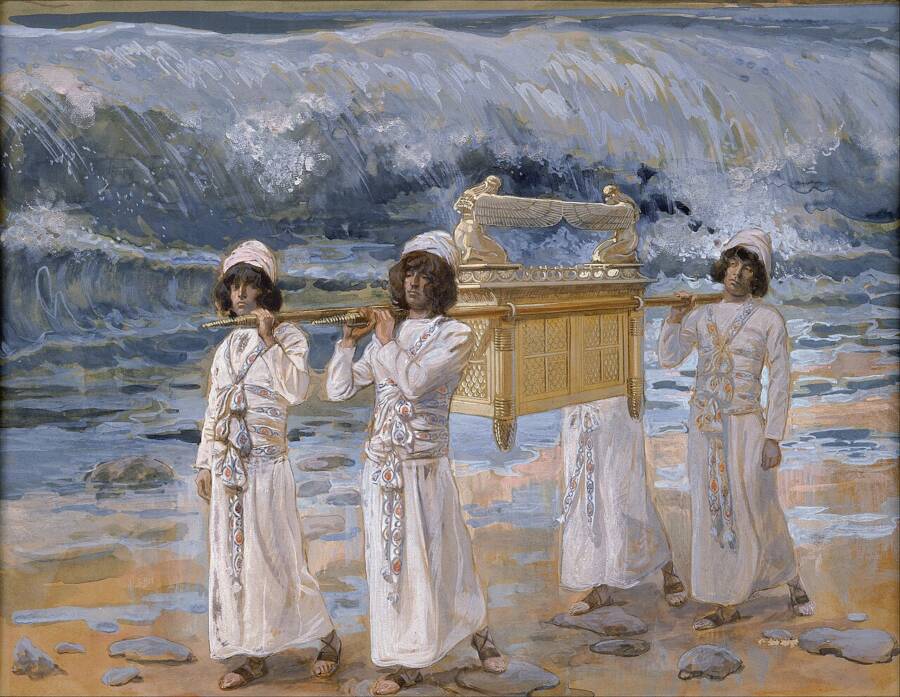An elaborate gold-plated, wooden chest, the Ark of the Covenant is believed to hold the original Ten Commandments — but where is it?

Public DomainThe Ark of the Covenant is an important holy object in Judaism and Christianity.
In the 1981 movie Raiders of the Lost Ark, Indiana Jones races to find the Ark of the Covenant before the Nazis do. But although the fictional adventure film includes one of the most famous modern references to the religious relic, this object is said to date back to ancient times, appearing in the Hebrew Bible and Christian Old Testament. So what is it?
Unlike other somewhat nebulous religious objects like the Holy Grail, the Ark of the Covenant is described in great detail in religious texts. There are stories about this Judeo-Christian relic’s provenance, power, and purpose.
That said, many questions about the Ark of the Covenant remain: Is it real? Does it actually have miraculous powers? And if so, what happened to it?
What Is The Ark Of The Covenant?
The Ark of the Covenant is an ornate, gilded chest that appears in the Hebrew Bible and the Christian Old Testament. Purportedly built some 3,000 years ago by the Israelites, the Ark is said to contain the original stone tablets engraved with the Ten Commandments, the laws that Jews and Christians believe were written by God and given to Moses at Mount Sinai.
The Book of Exodus explains how God instructed Moses to tell the Israelites to build the Ark that would hold the original Ten Commandments. As Exodus tells it, these building instructions were quite specific:
“Have them make an ark of acacia wood—two and a half cubits long, a cubit and a half wide, and a cubit and a half high. Overlay it with pure gold, both inside and out, and make a gold molding around it. Cast four gold rings for it and fasten them to its four feet, with two rings on one side and two rings on the other. Then make poles of acacia wood and overlay them with gold. Insert the poles into the rings on the sides of the ark to carry it. The poles are to remain in the rings of this ark; they are not to be removed. Then put in the ark the tablets of the covenant law, which I will give you.”
Though the Book of Exodus describes the Ark as being made per God’s precise instructions (which also included an “atonement cover of pure gold” with “two cherubim [made] out of hammered gold at the ends of the cover”), the Book of Deuteronomy suggests that it’s made simply of wood.

Public DomainAn artistic depiction of Moses and Joshua bowing before the Ark of the Covenant.
In addition to the Ten Commandments, the Ark is also said to contain Aaron’s rod. Aaron was the brother of Moses and his rod purportedly boasted numerous otherworldly powers, including transforming into a snake, summoning gnats and frogs, and turning water into blood.
And much like Aaron’s rod, the Ark of the Covenant itself was also said to possess magical powers and incredible abilities.
The Ark Of The Covenant’s Miraculous Powers
Jews and Christians not only believe that the Ark of the Covenant holds holy objects, but they also believe the chest has immense powers of its own.
In the Old Testament, the Ark is linked to a number of miracles. For example, it’s said that the object cleared dangers like poisonous animals out of the way of the Israelites during their Exodus out of Egypt, according to National Geographic. The Ark was also said to have stopped the flow of the Jordan River, which allowed them to cross into the Promised Land.
“So when the people broke camp to cross the Jordan, the priests carrying the ark of the covenant went ahead of them,” the Book of Joshua states. “Now the Jordan is at flood stage all during harvest. Yet as soon as the priests who carried the ark reached the Jordan and their feet touched the water’s edge, the water from upstream stopped flowing.”

Public DomainA depiction of the Israelites carrying the Ark of the Covenant across the Jordan River.
The Book of Joshua continues: “So the people crossed over opposite Jericho. The priests who carried the ark of the covenant of the Lord stopped in the middle of the Jordan and stood on dry ground, while all Israel passed by until the whole nation had completed the crossing on dry ground.”
The religious relic also played a role in the Battle of Jericho, when it was purportedly carried by the Israelites for a week as they surrounded the city. After seven days, the city’s walls fell down, allowing the Israelites to take it.
When the Ark of the Covenant was eventually stolen by the Philistines, however, they were unable to harness its powers. Instead, the Philistines were tormented by disease until they returned the Ark to the Israelites.
But what happened to the chest after Biblical times?
The Enduring Mystery Of The Relic’s Location
For centuries, the Ark of the Covenant has inspired countless questions among believers and skeptics alike. Some have questioned whether this object existed at all. Much of what we know about the relic comes from religious texts, and it’s difficult to find confirmation of its existence by secular sources. Roman-Jewish historian Flavius Josephus made several references to the object in his famed text The Antiquities of the Jews, but he likely got the bulk of his information about the Ark from scripture.
Because of this, whether or not people think the Ark is real depends largely on what they believe. Most Jews and Christians agree that the Ark did exist and that it did have God-given powers. But believers differ in regard to what they think happened to the Ark. According to Live Science, Biblical scholars can trace the path of the Ark of the Covenant — but only to a certain point.
Most Biblical scholars say that the Ark apparently made its way to Ancient Israel and was later placed in Jerusalem’s Temple of Solomon, which was established around 957 B.C.E. It probably stayed in that building for a few centuries, at least until the Babylonians destroyed Jerusalem in 586 B.C.E. But from there, the Ark of the Covenant’s trail becomes difficult to follow.

Public DomainA 1650 painting entitled “The Transfer of the Ark of the Covenant by the Singing and Dancing King David.”
Since the Babylonians sacked Jerusalem, it’s possible that they took the Ark or destroyed it. However, it’s not among their documented spoils. Meanwhile, the Books of the Maccabees — and also the Quran, the holy book of Islam — suggest that the Ark was hidden in a cave on Mount Nebo by the prophet Jeremiah. Jeremiah allegedly proclaimed that the “place shall remain unknown until God gathers his people together again and shows his mercy.”
It’s also been claimed that the Ark of the Covenant ended up in present-day Ethiopia. Some believe that the Ark is held at the Church of Our Lady Mary of Zion in the city of Axum, where only its “Guardian” can look upon it.
This — like other theories about the Ark’s location — has never been confirmed. In fact, Live Science notes that a scholar who purportedly saw the Ethiopian Ark during World War II declared that it was not the original.
So where is the original Ark of the Covenant today? Like many other religious relics, its whereabouts are a mystery. Maybe the Ark was destroyed, maybe it was hidden — and maybe it’s waiting for the right time to reemerge.
For Christian believers, the Book of Revelation suggests that the Ark of the Covenant will not be seen again until the end times, stating:
“Then God’s temple in heaven was opened, and within his temple was seen the ark of his covenant. And there came flashes of lightning, rumblings, peals of thunder, an earthquake and a severe hailstorm.”
After reading about the Ark of the Covenant, go inside the complex question of who wrote the Bible. Or, see how the Bible actually describes angels.





